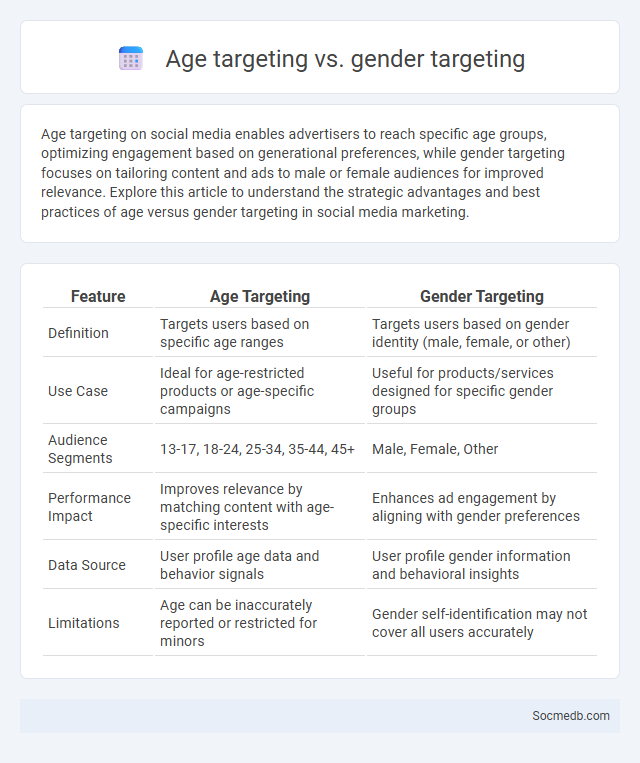
Photo illustration: Age targeting vs Gender targeting
Age targeting on social media enables advertisers to reach specific age groups, optimizing engagement based on generational preferences, while gender targeting focuses on tailoring content and ads to male or female audiences for improved relevance. Explore this article to understand the strategic advantages and best practices of age versus gender targeting in social media marketing.
Table of Comparison
| Feature | Age Targeting | Gender Targeting |
|---|---|---|
| Definition | Targets users based on specific age ranges | Targets users based on gender identity (male, female, or other) |
| Use Case | Ideal for age-restricted products or age-specific campaigns | Useful for products/services designed for specific gender groups |
| Audience Segments | 13-17, 18-24, 25-34, 35-44, 45+ | Male, Female, Other |
| Performance Impact | Improves relevance by matching content with age-specific interests | Enhances ad engagement by aligning with gender preferences |
| Data Source | User profile age data and behavior signals | User profile gender information and behavioral insights |
| Limitations | Age can be inaccurately reported or restricted for minors | Gender self-identification may not cover all users accurately |
Understanding Age Targeting: Precision and Limitations
Age targeting on social media platforms allows you to deliver content and advertisements to specific age groups based on user data, optimizing campaign relevance and engagement. Precision is achieved through algorithms that analyze user behavior, profile information, and demographic insights, but limitations arise from inaccurate or incomplete data, privacy settings, and age misreporting. Understanding these factors helps refine your marketing strategies while managing expectations around the effectiveness of age-targeted efforts.
Gender Targeting: Customizing Campaigns by Identity
Gender targeting in social media campaigns involves analyzing user data to deliver personalized content that resonates with specific gender identities, improving engagement and conversion rates. Platforms like Facebook and Instagram offer advanced demographic filters, enabling advertisers to tailor ads based on gender identity, interests, and behaviors. Customizing campaigns by identity not only enhances relevance but also fosters inclusivity and brand loyalty among diverse audiences.
What Is Audience Targeting? A Holistic Approach
Audience targeting is a strategic process that involves identifying and segmenting your ideal customers based on demographics, interests, behaviors, and online activity to deliver personalized content and ads through social media platforms. This holistic approach integrates data analytics, machine learning, and customer insights to refine targeting accuracy and enhance engagement, ensuring your marketing efforts reach the most relevant users. By leveraging these techniques, you can maximize ROI and create meaningful connections with Your audience in an increasingly competitive digital landscape.
Key Differences: Age vs Gender vs Audience Targeting
Social media strategies vary significantly based on age, gender, and audience targeting, each requiring tailored content and engagement approaches to maximize impact. Age targeting focuses on generational behavior and platform preferences, while gender targeting emphasizes differentiated interests and communication styles. Understanding these key differences helps you optimize campaigns to effectively reach and resonate with your desired audience segments.
The Benefits and Risks of Age-Based Advertising
Age-based advertising on social media enables precise targeting, increasing campaign effectiveness by reaching relevant audiences such as millennials or Gen Z with tailored content. This method enhances user engagement and improves return on investment by avoiding irrelevant ads, yet it raises concerns regarding privacy, data security, and the ethical use of personal information. Marketers must balance the advantages of personalized ads with potential risks like age discrimination, data misuse, and the impact on vulnerable age groups.
Leveraging Gender Data for Higher Engagement
Leveraging gender data in social media campaigns enhances targeting accuracy and maximizes audience engagement by tailoring content to resonate with specific preferences and behaviors. Analyzing gender-specific trends and interaction patterns helps optimize post timing, tone, and imagery to align with your audience's expectations. By integrating these insights into your strategy, you can boost click-through rates, shares, and overall user interaction significantly.
Audience Targeting: Combining Demographics, Interests, and Behaviors
Effective audience targeting on social media integrates demographics such as age, gender, and location with user interests and online behaviors to deliver highly personalized content. Leveraging data analytics and machine learning models enhances the precision of targeting by identifying patterns in user engagement, purchase history, and browsing activity. This multi-dimensional approach increases conversion rates and optimizes ad spend by reaching users most likely to interact with the brand.
Case Studies: Successful Campaigns Using Each Method
Coca-Cola's "Share a Coke" campaign utilized personalized content on social media, resulting in a 7% sales increase and over 500,000 user-generated photos shared on Instagram. Nike's "Dream Crazy" campaign leveraged influencer partnerships and emotional storytelling on Twitter and YouTube, driving a 31% increase in sales within a month. Airbnb's use of targeted Facebook ads and user testimonials led to a 40% rise in bookings and a significant boost in global brand engagement.
Choosing the Right Targeting Strategy for Your Brand
Selecting the right targeting strategy for your brand on social media involves analyzing audience demographics, interests, and behaviors to ensure precise ad delivery. Leveraging tools like Facebook Pixel and Instagram Insights helps refine your targeting by tracking user interactions and engagement patterns. You can maximize your marketing ROI by tailoring content to specific segments that align with your brand's goals and values.
Future Trends: The Evolution of Targeting in Digital Marketing
The future of digital marketing lies in hyper-personalized social media targeting driven by AI and machine learning algorithms that analyze vast user data for precise audience segmentation. Predictive analytics will enable marketers to anticipate consumer behavior, optimizing ad spend and content delivery on platforms like Instagram, TikTok, and LinkedIn. Your campaigns will benefit from augmented reality experiences and voice search integration, creating immersive interactions that boost engagement and conversion rates.
 socmedb.com
socmedb.com